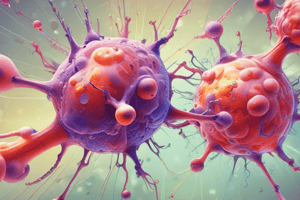Podcast
Questions and Answers
Which of the following is NOT a characteristic of cytokines?
Which of the following is NOT a characteristic of cytokines?
- Relatively small proteins with a molecular mass less than 30 kDa
- Have a molecular mass greater than 30 kDa (correct)
- Belong to one of six groups, including the Interleukin 1 (IL-1) family
- Often glycosylated, which contributes to cytokine stability
Which family of cytokines is responsible for promoting proinflammatory signals?
Which family of cytokines is responsible for promoting proinflammatory signals?
- Interleukin 17 (IL-17) family
- Interferon (Class II cytokine) family
- Interleukin 1 (IL-1) family (correct)
- Hematopoietin (Class I cytokine) family
Which of the following is NOT a characteristic of the Interleukin 1 (IL-1) family of cytokines?
Which of the following is NOT a characteristic of the Interleukin 1 (IL-1) family of cytokines?
- Generally anti-inflammatory, inducing a decrease in capillary permeability and leukocyte migration (correct)
- Contribute to the amplification of the inflammatory response
- Stimulated by recognition of viral, parasitic, or bacterial antigens by innate immune receptors
- Secreted very early in the immune response by dendritic cells and monocytes or macrophages
Which of the six families of cytokines is known to be involved in the regulation of hematopoiesis?
Which of the six families of cytokines is known to be involved in the regulation of hematopoiesis?
Which family of cytokines is responsible for antiviral and antiproliferative effects?
Which family of cytokines is responsible for antiviral and antiproliferative effects?
Which cytokine family is primarily involved in the recruitment and activation of leukocytes during an inflammatory response?
Which cytokine family is primarily involved in the recruitment and activation of leukocytes during an inflammatory response?
What do chemokines primarily do?
What do chemokines primarily do?
What was the significant activity of cytokines first recognized in the mid-1960s?
What was the significant activity of cytokines first recognized in the mid-1960s?
What is the function of Mitogens as described in the text?
What is the function of Mitogens as described in the text?
What technology allowed for the production of artificially generated T-cell tumors that constitutively produced IL-2?
What technology allowed for the production of artificially generated T-cell tumors that constitutively produced IL-2?
What did gene cloning techniques in the 1970s and 1980s make possible?
What did gene cloning techniques in the 1970s and 1980s make possible?
How did researchers identify cell lines dependent on specific cytokines?
How did researchers identify cell lines dependent on specific cytokines?
What is the primary function of chemokines?
What is the primary function of chemokines?
What cellular process do chemokines influence to mobilize immune cells?
What cellular process do chemokines influence to mobilize immune cells?
What is the reason behind the naming of interleukins?
What is the reason behind the naming of interleukins?
Which of the following is NOT an example of an interleukin?
Which of the following is NOT an example of an interleukin?
Which immune cell type secretes Interleukin 1 (IL-1)?
Which immune cell type secretes Interleukin 1 (IL-1)?
What is the primary function of cytokines in general?
What is the primary function of cytokines in general?
Study Notes
Cytokines and Chemokines
- Cytokines can signal immune cells to increase or decrease enzyme activity, change their transcriptional program, and alter their effector functions.
- They can also instruct cells when to survive and when to die.
Interleukins
- Interleukins are cytokines that communicate between white blood cells (leukocytes).
- Examples: Interleukin 1 (IL-1) secreted by macrophages, Interleukin 2 (IL-2) secreted by activated T cells.
Chemokines
- Chemokines are a subpopulation of cytokines that mobilize immune cells from one organ to another.
- They belong to the class of molecules called chemoattractants, which attract cells by influencing cytoskeleton proteins and cell-surface adhesion molecules.
- Chemokines attract cells with the appropriate chemokine receptors to regions with the highest chemokine concentration.
Cytokine Families
- Cytokines belong to one of six families: Interleukin 1 (IL-1), Hematopoietin (Class I), Interferon (Class II), Tumor Necrosis Factor (TNF), Interleukin 17 (IL-17), and Chemokine families.
- Cytokines are relatively small proteins with a molecular mass of less than 30 kDa, and many are glycosylated.
IL-1 Family
- Cytokines of the IL-1 family promote proinflammatory signals.
- They are typically secreted by dendritic cells and monocytes/macrophages in response to viral, parasitic, or bacterial antigens.
- IL-1 family members induce an increase in capillary permeability and amplify leukocyte migration into infected tissues.
General Properties of Cytokines and Chemokines
- Cytokines were first recognized in the mid-1960s as soluble factors regulating proliferation, differentiation, and maturation of immune system cells.
- Hybridoma technology and gene cloning techniques enabled the production of pure cytokines and identification of cell lines dependent on particular cytokines.
Studying That Suits You
Use AI to generate personalized quizzes and flashcards to suit your learning preferences.
Description
This quiz covers the role of cytokines in signaling immune cells, influencing enzyme activity and transcriptional programs, and regulating cell survival. Learn about the classification of cytokines as Interleukins and their communication between white blood cells.




